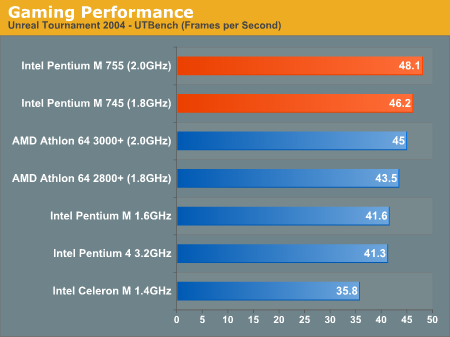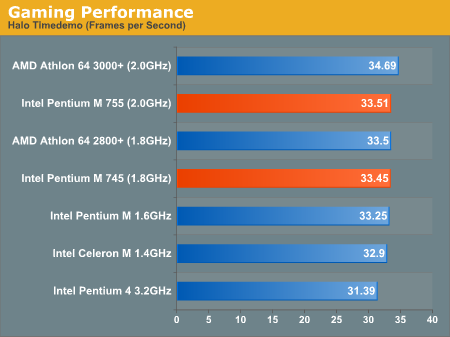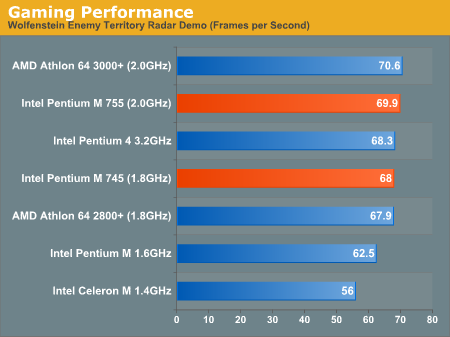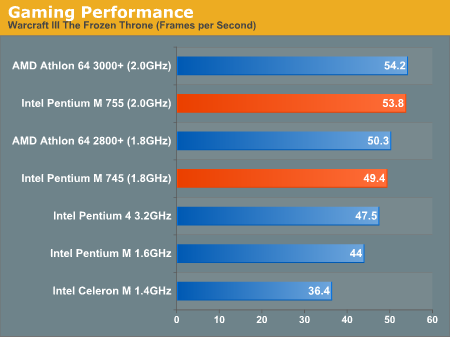Intel's 90nm Pentium M 755: Dothan Investigated
by Anand Lal Shimpi on July 21, 2004 12:05 AM EST- Posted in
- CPUs
Gaming Performance
Mobile gaming is still nowhere near as popular as desktop gaming, but thanks to the efforts of ATI and NVIDIA, it is finally possible.
Under UT2004, the Pentium M manages to outperform the rest of the chips, delivering the highest frame rates. But, keep in mind that even at the low 800x600 resolution we were testing at, the game was still mostly GPU limited by the mobility Radeon 9600.

The performance under Halo, even at 800x600, is mostly GPU limited and thus we see the Athlon 64 3000+ at the top with most of the other contenders.

Under Final Fantasy, the Pentium M takes a backseat to only the Athlon 64. Clock for clock, the Athlon 64 does come out ahead by a negligible 4%.

Here, we have yet another close call, thanks to GPU limitations. Really, only the Pentium M 1.6 and Celeron M 1.4 perform poorly here.

Under Warcraft III, thanks to Blizzard's excellent work at reducing GPU requirements while still making a beautiful game, we finally see some differences between the chips. The Athlon 64 3000+ and Pentium M 755 once again battle it out at the top; and even the Pentium M 745 doesn't mind giving the Pentium 4 3.2 a run for its money.
It would be nice to see what the Pentium M could really do without being held back by a mobile GPU. Unfortunately, there are no decent Pentium M motherboards with an AGP slot that were readily available at the time of this review. Needless to say, the Pentium M can hang with the best of them when it comes to mobile gaming.










28 Comments
View All Comments
phtbddh - Wednesday, July 21, 2004 - link
What is the battery life of a Dothan compared to a Banias? I know the Dothan is suppose to be better, but can we see some numbers?tfranzese - Wednesday, July 21, 2004 - link
Not quite SKiller, a large part of the P4's dominance in media encoding is the high core frequency attributed to such a long pipeline.SKiller - Wednesday, July 21, 2004 - link
I think the assertion that.."With Intel's vision for the future being centered on media encoding and content creation, the Pentium M is the last thing that Intel would want to build their future desktop CPUs around."
..may not be correct as by your own admission:
"Partially constrained by its 400MHz FSB and single channel memory interface, the Pentium M is not the successor to the Pentium 4 that many will make it out to be."
So all Intel would have to do is up the FSB on a desktop version to improve media encoding and content creation performance and be competitive with P4.
mkruer - Wednesday, July 21, 2004 - link
you know i wonder just how much of the preformance is gained from the 2MB of L2 cache. If I recall from Aceshardware the 2MB is the sweetspot For mico op code, any more, and there is a preformance hit in either direction, Also on a side note. The 90nm Athlon 64 show a ~5% improvement across the board.dvinnen - Wednesday, July 21, 2004 - link
Yea, I was wondering the same thing. Why not just use a mobile A64 system with a mobile 9600. Acer and emachines make systems with them.alexruiz - Wednesday, July 21, 2004 - link
Another one: Was that difficult to get an eMachines M68xx for the review? Mobile against mobile.alexruiz - Wednesday, July 21, 2004 - link
Anand made a huge mistake in the Athlon 64 CPU selection. The mobile [b]A64 3000+ is clocked at 1.8 GHz with a 1MB L2 cache[/b]. He used a desktop 2.0 GHz with 512 K. This will affect the outcome, specially because clock speed matters more cache.I knew Dotham was going to give a very good fight, but I didn't expect it to win any gaming application ot Business Winstone. As reference, my M6805 A64 3000+ scores 22.2 and 27.8 in the BW and CCMW tests (7K60 hard drive, so not the same setup)
A very good review, but we can do better. I still want to see video encoding tests run with a commercial application, preferably 3 (Ulead Video Studio 8, Roxio Videowave 7, Pinnacle 9) and 2 alternative programs for DivX encoding (DVD2AVI and virtualdubmod are suggested. We have seen enough XMPEG from other sites)
Run some photoedition benchmarks not only with Adobe, but also with Corel Photopaint 11 or Roxio Photosuite.
AutoCAD is also expected to give an idea of what be attained. SolidWorks or UG would be fantastic, but those 2 are more of a wish.
How about more scientific or technical programs? Electrical simulators (PSpice for example), FEA (Nastran), MathCAd, Maple, etc.
More games were expected to be run. Howe about chess programs? How about OSmark, the succesor of COSBI by Van Smith?
I stressed the use of 2 or more applications that do the same to highlight the fact that software optimization matters a lot and that some myth about a CPU being "the best for that activity" are only myths.
All in all, Dotham is a potent rival that uncovers some weaknesses in the K7/K8 architecture that were noticeable against the P6 (Pentium II/III) but forgotten against the P7 (Pentium 4): [b]L2 cache performance[/b] and integer performance.
Regarding battery life keep in mind that the CPU is not the biggest spender in a laptop, the screen is. The K8T800, the most popular chipset for AMF64 laptops is a desktop part, and is quite voracious. Keep those factor when battery life is evaluated.
I foresee that SOI will give AMD the edge in battery life once they implement power saving caches, the biggest energy conservation feature in the P-M.
Comments are welcome
Alex
dacaw - Wednesday, July 21, 2004 - link
Well Dothan looks very much like a copy of a 32-bit AthlonXP to me.Comparing it to an Athlon64 makes no sense. Dothan is not 64-bit.
I bought an AthlonXP Barton mobile 2600 for $99 and it runs barely warm under PowerNow. What could you buy for the price of a Dothan? Maybe 5 top-of-the-line Athlon XPs?
Let's compare apples to apples and have a review of top-of-the line Dothan to top-of-the-line AthlonXP.
Oh, and drop those fake synthetic benchmarks. What point are they if they simply "favor" Intel processors (your comment in the review).
Come on Anand, lets have a review that really means something. Please!
Jeff7181 - Wednesday, July 21, 2004 - link
Can't wait to see battery life tests.mino - Wednesday, July 21, 2004 - link
Nice review, however it is a shame you didn't include Celeron 2.4 (which could be find in many SLOW notebooks) and also AXP-M 2600+ would be nice. -> this way it would be a complete notebook market review. - The best one.I'll love to see bench results of Cely and XP added (by using same desktop platform as you did in case of P4)
mino